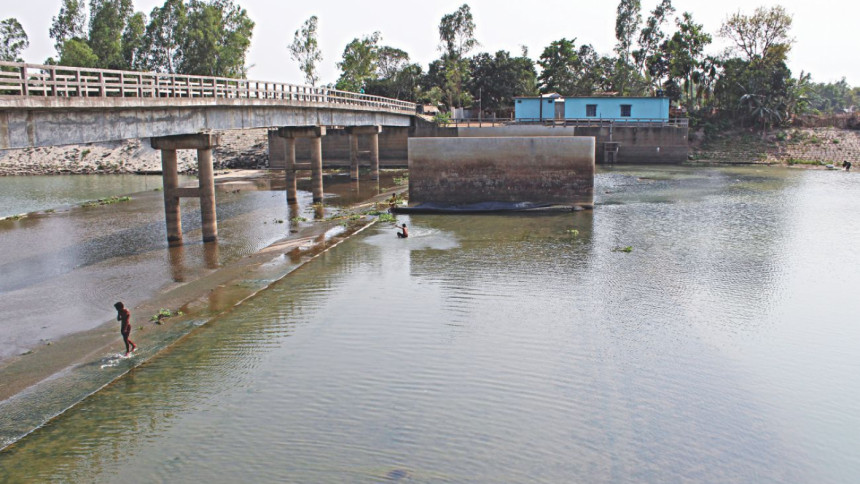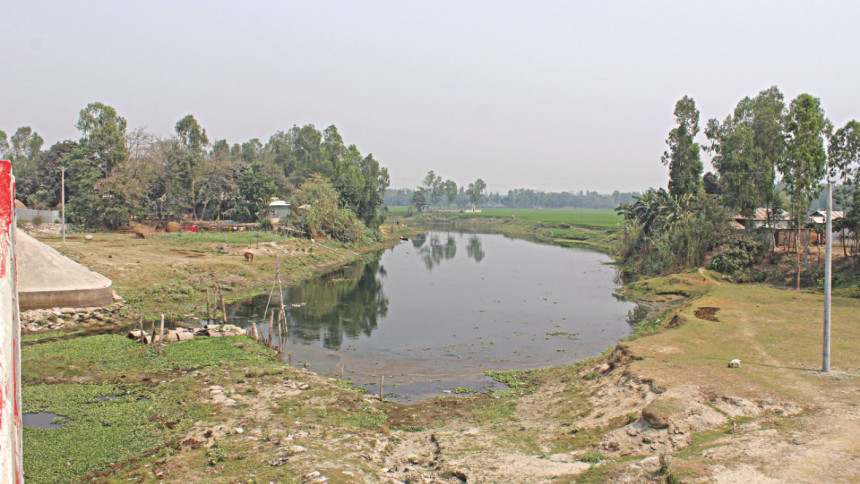A River Dies in Kurigram

"Is there a river called Jinjirum that's a trans-boundary river? Are you sure about its name? Is it the name of the locality or the river? I haven't even heard about it," says a high-ranking official of the northern zone of Bangladesh Water Development Board (BWDB), when we asked him about different issues faced by this river and the communities dependent on it. Jinjirum river might be one of the least important issues for BWDB but for more than 2,00,000 people in Northern Bangladesh, it is their lifeline. It supports their agriculture, provides them with fish and freshwater and, in the remote northern border areas of Bangladesh, where transport infrastructure is inadequate and handicapped by constant river erosion, the river used to serve as a natural highway that connected communities. As a navigable trans-boundary river, it also has immense potential as a trade route between Bangladesh and North-Eastern India, which can reduce transportation costs significantly. However, due to lack of supervision and certain reckless activities, this river is now on the brink of extinction.
Jinjirum originates in the hills of Assam, flows through Meghalaya and then enters Bangladesh through Rowmari upazila of Kurigram district. The river continues its journey eastwards and enters Jamalpur district. In Dewanganj of Jamalpur district, it connects with the shrinking old Brahmaputra river and feeds the old Brahmaputra floodplain, stretching from south-western parts of the Garo Hills to the eastern parts of the Madhupur tract. According to the book Bangladesh er Nod Nodi: Bartaman Goti Prokriti by Manik Mohammad Razzak, the length of the Bangladeshi portion of the Jinjirum is 55 kilometres, its average width is 107 metre and its average depth is seven metres. In Bangladesh, the area of its basin is 240 square kilometres. Before partition, this river used to serve as one of the major links between the hills of the greater Assam and the plains of Assam and Eastern Bengal.

Like several trans-boundary rivers, one of Jinjirum's flows that enters Bangladesh through Rowmari is almost dead due to the construction of border roads in the Indian side of the river. Sheikh Rokon, an eminent river researcher and secretary general of Riverine People says, "A flow of Jinjirum empties into Brahmaputra. But the other flow that enters Bangladesh through Rowmari is completely obstructed by the Indian border roads. A shallow stream that enters through Rowmari is fed mostly by rainwater and some water from the Chatlar Beel (a wetland)." In fact, when we visited the area, we found that the shrinking flow has dried up completely at the point it enters Bangladesh; after a few hundred metres into Bangladeshi territory, the riverbed becomes entirely unrecognisable. As the soft clay of the dried-up river bed is an excellent raw material for brick manufacturing, brickfields have flourished adjacent to the riverbed. Stone crushing yards have also been established on the riverbed due to proximity with Rowmari landport through which huge quantity of stones are imported from India. A once lush green countryside fed by the serene flow of Jinjirum has been replaced with stone quarries and brickfields producing toxic air and creating unbearable sound pollution.
However, a few kilometres eastwards, Jinjirum's flow starts to change gradually. From occasional clogged water holes, the river starts to swell again and gets its navigability back thanks to two other trans-boundary rivers called Donni and Kalo. These are spring-fed, fast flowing hilly rivers which originate in the hills of Meghalaya. After taking a horse-shoe turn, Jinjirum connects with Kalo river at a place called Bunder Char and takes another horse-shoe turn and meets with Donni river at a place called Dublabari. From this place, Jinjirum flows with its full force up to a place called Bikribeel, which is around three kilometres away from Dublabari. The eroding banks reveal how the river frequently turns destructive in these parts. Bakbandha is a fishing village located between Dublabari and Bikribeel. There, we talked to Abdul Mutalib, an octogenarian fisherman who knows the river extensively from his childhood.

"Only 20-25 years ago, the river looked quite different. It was wider and deeper," recalls Abdul. "We never faced erosion along Jinjirum. Both the banks of the rivers were plentiful and the villages were prosperous. I have caught monstrous catfish in this river each weighing 100-150 kilograms. We also caught Hilsa fish in this river. Within a decade, the river has changed so drastically that sometimes I cannot believe it. There is no fish in this river anymore. Both the banks have been eroding constantly. My house, my vegetable patch, my cattle pen have all been eaten up by the river. Now, I live in a rented shanty and work as an agricultural labourer."
What turned this once tranquil and plentiful river into a barren and devastating current?
The answer lies at Bikribeel, two kilometres downstream of the river. At Bikribeel, the local government engineering division (LGED) erected an inflatable rubber dam to provide irrigation for the local farmers. The construction project started in 2009 (effectively from 2012) and the dam was commissioned in 2017. Tk 155,804,000 has been spent to construct the dam. However, such expensive infrastructure now lies completely useless. The river Donni alone cannot provide sufficient water to activate the dam and to feed the irrigation channels. The concrete structure of the dam beneath the river is obstructing the natural flow of the river. Because of the height of the concrete slabs, fish movement has halted and gradually the river is losing her capacity to support a large fish population. Many fishermen like Abdul have abandoned their ancestral profession as they cannot catch anything but some small fry in the waters of Jinjirum.

Sheikh Rokon, explains further, "Jinjirum is a grassy river which is fed mainly by rainwater and flash floods. Fish from sandy rivers like Brahmaputra have to migrate to small rivers like Jinjirum for breeding. If Jinjirum is destroyed, the ecosystem of the entire Brahmaputra floodplain will be affected. Installing a rubber dam on such a river is an absolutely thoughtless initiative because besides destroying the ecosystem, it will also cause river erosion."
A field level official of LGED, who requested anonymity, explains how the dam is causing river erosion. "As Jinjirum does not receive water from the original source due to the dam on her upstream, damming up this river was not necessary and not effective at all. Currently by obstructing the flow of the river, the structure is accelerating siltation. Decades ago, two flows, one from the hills of Assam and one from the hills of Meghalaya, used to meet at Jinjirum river. The combined current used to eliminate each other's individual forces and flow through a wider course. Since the original flow from the hills of Assam has been completely blocked, the flash floods from the Meghalayas hit the banks unopposed. Since the river is losing her depth due to siltation, it is not able to contain rainwater and flash flood. Ultimately, the banks will overflow and be eroded," he explains. Siltation has also encouraged illegal sand-mining. We spotted at least six sand mining machines within two kilometres of Jinjirum from Dublabari to Bikribeel. According to BWDB and LGED officials, sand mining from Jinjirum is illegal because it destroys the riverbed and accelerates river erosion. However, we did not see any initiative to stop the ongoing sand-mining. As a result, hundreds of villages in two districts (Kurigram and Jamalpur) along the Jinjirum river are becoming victims of river erosion every year during monsoon.
Besides, the dam has also turned the river unnavigable. Once, the merchants used to ply the river to market their goods at Dewanganj bazaar in Jamalpur district. Even the local stone merchants said that if this river could be used to import stones from India, the transportation cost would have been reduced to half. In 2016, an initiative was also taken to use the river for cross-border trade. Alhajj Mohammad Jahidul Islam, general secretary, association of coal and stone importers of Rowmari, says, "We have been requesting the government to make the river navigable for cross border trade since more than two decades. We saw a glimmer of hope in 2016 when the then director general of BGB and divisional commissioner promised that the river would be used for cross-border trade from 2017. But the rubber dam has destroyed all our hopes. To import stone and coal from Meghalaya through Rowmari landport, we have to cross two Indian states and pay high taxes. The road is also very bad. But we could easily transport the goods through this river."
When asked about the dam and its adverse impacts, Khalilur Rahman, additional chief engineer, LGED, says, "We along with China Institute of Water Resources and Hydropower Research jointly conducted a feasibility study to assess the potential of inflatable rubber dams. In many parts of Bangladesh, farmers are getting benefits of our project. But the case for Jinjirum river is different. The local people have been demanding at least two bridges across the river for a long time. We are now training the river to construct these bridges which have temporarily blocked the current. But once the bridges are built, the dam will become fully operational." When asked about the measures they have taken to prevent river erosion, Khalilur replies, "It's BWDB's job. They have their own project in this regard."
Md Ariful Islam, executive engineer, BWDB, could not give us any hope. He says that currently there is no project on Jinjirum River. "Two years ago, we did some protective works but there is no such project in the near future. Since it's a trans-boundary river, any kind of water regulation, restoration and maintenance project on the river should be done through international agreement. Regarding the rubber dam, it is quite obvious that installing such structure on a river will definitely obstruct its flows, increase siltation and fish migration to the downstream will be hampered. We don't know why LGED installed the dam there. Unfortunately, they didn't consult with us before constructing the dam."
While the government officials are blaming each other and casting an indifferent look at the problem, more than two hundred thousand people dependent on Jinjirum river are at risk of losing their livelihood. They are appealing to save the river and save their lives. Compared to large trans-boundary rivers such as Teesta, Brahmaputra and Ganges, Jinjirum might be a small river but it plays a vital role in running economic activities and sustaining lives all over the Brahmaputra flood plain. If actions are not taken now, hundreds of thousands living in the Jinjirum basin may face extreme poverty in the near future.
Md Shahnawaz Khan Chandan can be contacted at shahnawaz.khan@thedailystar.net


 For all latest news, follow The Daily Star's Google News channel.
For all latest news, follow The Daily Star's Google News channel. 



Comments